Flora of Nepal
The flora of Nepal is incredibly rich and great to observe. There are 7000 flowering plants belonging to more than 200 families and 1500 genera. Nepal is located at the centre of the Himalaya and has 283 endemic species of flowering plants.
Himalayan flowers
Mountains (Himalaya range) cover a big part of Nepal and we normally consider 3 differents regions in the country: High mountain (altitude above 4700m), Hills (from 600m to 4700m) and plains of Teraļ (50m to 600m). Himalaya is densely wooded (lower than 3000m) at lower elevations in the south. Above these lush green humid forests, the home of orchids and other beautiful flowers, succeed cooler, temperate evergreen confier forest of spruce, fir, deodar, juniper, etc. At elevations higher than these forests, known as the treeline (or timberline), characterized by dwarf juniper-birch-bush rhododendrons, the climate is totally unfavorable for the growth of trees. Above this timberline, on can find open vegetation of strange, stunted shrubs and incredibly delicate herbs up to 6300m (above the limits of permanent snow that lies at 5200m). This is the unknown world of Himalayan flowers.
The elevated region above the treeline is inapproprietly called the alpine zone. For Himalaya, this term is innaplicable where the real alpine zone is very localized and narrow belt of relatively low altitude. The plant life on the Himalaya exist, however at much higher elevations in the so called high alpine, nival, aeolian and arctic zones.
Indeed plants grow at extreme high altitudes, where the pronounced oxygen deficiency of the air almost excludes all vertebrates and most other animals, except perhaps some highly specialized insects. The highest altitude in the world, at which flowering plant (Christolea Himalayensis) grows is 6300m on Mt. Kamet. Enchangtingly beautiful flowering cushions of Stellaria decumbens flourish luxuriantly at 6140m) on Mt. Makalu. Between 4100 and 5800m above sea elevation, many delicate and lovely flowers bloom, totally unseen by man. The survivalof plants at such extreme high altitudes, under incredibly inhospitable conditions. above the permanent snowline, in dry, cold world of intense radiation, is possible only because of the abundant snow and ice. The strong summer insolation from the unfiltered solar radiation (unfiltered because of the extremely thin air) melts down the snowand ice to provide adequate moisture for the plants. The snow at this altitude also offers an effective prtective blanket to the dormant seeds and underground perennial stems of plants, during the long and extremely cold winter (temparature reaching -40).
Himalayan flowers families
We usually consider 23 different flowers families in the Himalaya region (Nepal)
1) Buttercup family - Ranunculacae
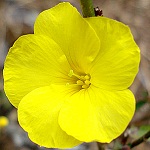 The buttercup family includes some of the most delicate and beautiful Himalayan flowers like: anemone, larkspur, marsh marigold, monkshood, columbine, trollius and pulsatilla. Many of these flowers are familiar garden plants in temperate land and in hills both in Nepal and in India. The aerial parts (outside the ground) are generally annual but they have perennial underground stout rootstock, whiuch remain dormant during the long winter season. They survive thanks to the cover that offer the cover of snow.
The buttercup family includes some of the most delicate and beautiful Himalayan flowers like: anemone, larkspur, marsh marigold, monkshood, columbine, trollius and pulsatilla. Many of these flowers are familiar garden plants in temperate land and in hills both in Nepal and in India. The aerial parts (outside the ground) are generally annual but they have perennial underground stout rootstock, whiuch remain dormant during the long winter season. They survive thanks to the cover that offer the cover of snow.
2) Poppy family - Papaveraceae
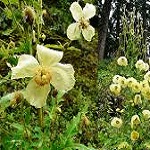 The poppy family os known for its great yellow juice and mostly delicate yellow flowers (sometimes deep red) with 5 papery membranous petals, usually in 2 whorls and very numerous stamens, single large ovary. tipped by a sessile large with or red stigma. The leaves of poppy flowers are divided and the lobes spiny tipped. The genus Meconopsis is a prickly herb with delicate yellow petals, growing in a semi-arid rocky area at 3900m of elevation. Some Himalayana poppy grow at an elevation of 3000m but some other such as the Himalayan Blue Poppy (Meconopsis sp.) can grow at an altitude of 4400 to 4500m abobve sea level.
The poppy family os known for its great yellow juice and mostly delicate yellow flowers (sometimes deep red) with 5 papery membranous petals, usually in 2 whorls and very numerous stamens, single large ovary. tipped by a sessile large with or red stigma. The leaves of poppy flowers are divided and the lobes spiny tipped. The genus Meconopsis is a prickly herb with delicate yellow petals, growing in a semi-arid rocky area at 3900m of elevation. Some Himalayana poppy grow at an elevation of 3000m but some other such as the Himalayan Blue Poppy (Meconopsis sp.) can grow at an altitude of 4400 to 4500m abobve sea level.
3) Mustard family - Cruciferae
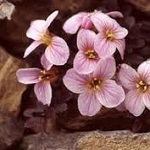 The flowers of the mustard family (scientifically called Cruciferae) are mostly yellow (but sometimes white), with 4 petals in 2 whorls, placed crosswide to ressemble the so called Maltese cross; the four petals also alternate with the petals to form a cross; the four stamens are in 2 whorls: an outer set of the 2 short and an inner set of 2 longer stamens. The 2-celled ovary develops into a curious, long semi-flat fruit, called silique that normally splits lengthwise into 2 parts from a central flat frame, to which the numerous small seeds are attached. To this family also belong many well-known cultivated plants like mustard, radish, cabbage, knol-kohl, cauliflower, turnip, etc.
The flowers of the mustard family (scientifically called Cruciferae) are mostly yellow (but sometimes white), with 4 petals in 2 whorls, placed crosswide to ressemble the so called Maltese cross; the four petals also alternate with the petals to form a cross; the four stamens are in 2 whorls: an outer set of the 2 short and an inner set of 2 longer stamens. The 2-celled ovary develops into a curious, long semi-flat fruit, called silique that normally splits lengthwise into 2 parts from a central flat frame, to which the numerous small seeds are attached. To this family also belong many well-known cultivated plants like mustard, radish, cabbage, knol-kohl, cauliflower, turnip, etc.
The family of Cruciferea are dominant members of the high altitude plant life of the Himalaya and grow luxuriante both in humid and arid area, steppes, often at extreme elevation above 5500m. To give some examples of this family and the elevation in which we can find them: Arabis tibetica between 3000m and 5000m, Draba alpina between 3600m and 4200m, Erysium altaicum at 4500m Christolea crassifolia can reach 6000m.
4) Pansy family - Violaceae
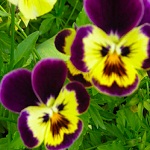 The Pansy family contains many lovely and delicate garden flowers, in which the large petal is usually spurred or enlarged like a sac at base. The creamy-white or birhgt yellow petals have large prominent red, brown or violet eye spot and tripes. The yellow part strongly relfect ultra-violet but the darker spots absorb it. Violaceae grows in sheltered rock crevices at an elevation of 3600m to 4200m; it is stemless or decumbent or much branched (depending on the area) herb, with long underground stolons and usually reniform or ovate leaves and blue or lilac flowers; the flowers are 2 types: one type has large petals and the other has either no petal at all or has small petals.
The Pansy family contains many lovely and delicate garden flowers, in which the large petal is usually spurred or enlarged like a sac at base. The creamy-white or birhgt yellow petals have large prominent red, brown or violet eye spot and tripes. The yellow part strongly relfect ultra-violet but the darker spots absorb it. Violaceae grows in sheltered rock crevices at an elevation of 3600m to 4200m; it is stemless or decumbent or much branched (depending on the area) herb, with long underground stolons and usually reniform or ovate leaves and blue or lilac flowers; the flowers are 2 types: one type has large petals and the other has either no petal at all or has small petals.
5) Pink family - Caryophyllaceae
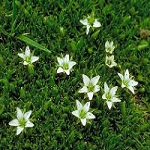 The Pink family (also called more scientifally Caryophyllaceae) of familiar garden flowers, occurs in sub-arid hight localities on the Himalaya, often at extreme high altitude. We can fin Pink family flowers at an elevation as high as 6000m. Here are some species of this beautiful and interesting flower family: Arenaria, Cerastium, Dianthus, Gypsophilia, Lychnis, Sagina, Silene, Stellaria. Those flowers usually have opposite leavesand brightly red coloured flowers with fringed petals and inflated calyx. The most remarkable are Stellaria deumbens found in bloom near Mt Everest (Sagarmatha mountain in Solu-khumbu area) at 6100m of elevation. Thylacosperrnum catspitosum a peculiar dome-shaped or hemispherical with minute hard leaves, in arid steppes at 4500 to 5500m on the Himalaya. we also find this flower in the Pamirs (Central Asia).
The Pink family (also called more scientifally Caryophyllaceae) of familiar garden flowers, occurs in sub-arid hight localities on the Himalaya, often at extreme high altitude. We can fin Pink family flowers at an elevation as high as 6000m. Here are some species of this beautiful and interesting flower family: Arenaria, Cerastium, Dianthus, Gypsophilia, Lychnis, Sagina, Silene, Stellaria. Those flowers usually have opposite leavesand brightly red coloured flowers with fringed petals and inflated calyx. The most remarkable are Stellaria deumbens found in bloom near Mt Everest (Sagarmatha mountain in Solu-khumbu area) at 6100m of elevation. Thylacosperrnum catspitosum a peculiar dome-shaped or hemispherical with minute hard leaves, in arid steppes at 4500 to 5500m on the Himalaya. we also find this flower in the Pamirs (Central Asia).
6) Geranium family - Geraniaceae
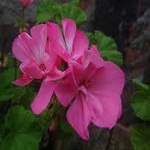 All of us is probably familiar with garden balsams and geranium, well-known for variegated flowers, often double under cultivation. Many species of balsams occur in the Himalaya and besides the common trifoliate Oxalis species with yellow and rose coloured flowers, others common in grassy meadows include Geranium collinum and Geranium pratense with large purple flowers, growing as prostrate, much bradnded boary herbs, with orbicular leaves, often 3 to 9 partites, at en elevation of 3600m. Geranium lambertii can be found at 3300,
All of us is probably familiar with garden balsams and geranium, well-known for variegated flowers, often double under cultivation. Many species of balsams occur in the Himalaya and besides the common trifoliate Oxalis species with yellow and rose coloured flowers, others common in grassy meadows include Geranium collinum and Geranium pratense with large purple flowers, growing as prostrate, much bradnded boary herbs, with orbicular leaves, often 3 to 9 partites, at en elevation of 3600m. Geranium lambertii can be found at 3300,
7) Pea family - Papilionaceae
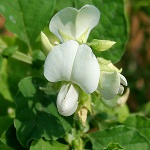 The Papilionaceae family (also called Pea family) is remarkable for the flowers peculiarly modified for butterfly pollination: one of the 5 petals nearest the main axis enlarges more than others and spreads out above as standard petal; 2 other petals immediatly below and in front of the standard petal remain short and close together and virtually enclose the remaining 2. The pistil and stamens are contained within them. Of the ten stamens, 9 are united into a tube and one remain free. The somewhat flattened ovary develops into a long pod called legume, in which the seeds arc attached to the long edge. The standard petal arc generally white, pink, violet or yellow or red and have brightly coloured streaks as honeyguides.
The Papilionaceae family (also called Pea family) is remarkable for the flowers peculiarly modified for butterfly pollination: one of the 5 petals nearest the main axis enlarges more than others and spreads out above as standard petal; 2 other petals immediatly below and in front of the standard petal remain short and close together and virtually enclose the remaining 2. The pistil and stamens are contained within them. Of the ten stamens, 9 are united into a tube and one remain free. The somewhat flattened ovary develops into a long pod called legume, in which the seeds arc attached to the long edge. The standard petal arc generally white, pink, violet or yellow or red and have brightly coloured streaks as honeyguides.
8) Rose family - Rosaceae
 Rosacea (Rose family) is probably the most highly prized of garden flowers, but the family includes many other valuable plants like apple, pear, prune, almonds, apricot, strawberry and bramble. In the wild state, the flowers have 5 sepals and petals, with numerous free stamens and carpels, enclosed in the hollowed-out thalamus, at the outer upper rim of which are five leafy speals. Besides the white and pink wild roses, we find on the Himalaya many beautyful species of Potentilla with yellow, pink of deep red flowers and Fragaria (wild strawberry) with white flowers; Potentilla argyrophylla has silky-white hairs and yellow flowers; Potentilla sibbaldia purpurea has large red flowers. Like the most Himalayan flowers, all these plants lie dormant during winter under the snow and with the coming of summer shoot forth to spread their beauty. Most Potentillas occur at all elevation between 3600m to 5800m. Potentilla cunata for instance occur at 4500m while wild white rose are at 3000m.
Rosacea (Rose family) is probably the most highly prized of garden flowers, but the family includes many other valuable plants like apple, pear, prune, almonds, apricot, strawberry and bramble. In the wild state, the flowers have 5 sepals and petals, with numerous free stamens and carpels, enclosed in the hollowed-out thalamus, at the outer upper rim of which are five leafy speals. Besides the white and pink wild roses, we find on the Himalaya many beautyful species of Potentilla with yellow, pink of deep red flowers and Fragaria (wild strawberry) with white flowers; Potentilla argyrophylla has silky-white hairs and yellow flowers; Potentilla sibbaldia purpurea has large red flowers. Like the most Himalayan flowers, all these plants lie dormant during winter under the snow and with the coming of summer shoot forth to spread their beauty. Most Potentillas occur at all elevation between 3600m to 5800m. Potentilla cunata for instance occur at 4500m while wild white rose are at 3000m.
9) Saxifraga family - Saxifragaceae
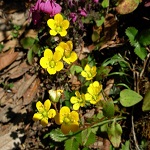 In Nepal, we only find Saxifraga flowers in the Himalaya, but they are widely cultivated in gardens in temperate lands. The Himalayan saxifrags are generally small herbs, with white or yellow flowers and often radical rosulate leaves. Saxifraga mucronulata is remarkable for its distribution extending from Greenland in the north to the Himalaya. Saxifraga hirculoides is another widely distributed species, with circumpolar range, Alps, Pamirs, Himalaya and Rocky mountains. It has beautiful yellow flowers, with some orange at base of the petals. There are several other species of Saxifraga, at elevation ranging from 3600m to 5000m. Saxifraga andersonii occur at 4300m.
In Nepal, we only find Saxifraga flowers in the Himalaya, but they are widely cultivated in gardens in temperate lands. The Himalayan saxifrags are generally small herbs, with white or yellow flowers and often radical rosulate leaves. Saxifraga mucronulata is remarkable for its distribution extending from Greenland in the north to the Himalaya. Saxifraga hirculoides is another widely distributed species, with circumpolar range, Alps, Pamirs, Himalaya and Rocky mountains. It has beautiful yellow flowers, with some orange at base of the petals. There are several other species of Saxifraga, at elevation ranging from 3600m to 5000m. Saxifraga andersonii occur at 4300m.
10) Crassula family - Crassulaceae
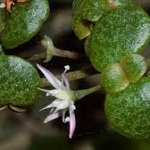 The Crassulaceae are succulents, often greatly fancied as rock-plants in garden, but the wild species are no less attractive. Rhodiola crenulatum blooms at an extreme elevation of 6000m while Rhodiola heterodonta with terminal yellow flowers and sessile succulent dentates leaves and Rhodiola wallichiana with rosulate think leaves and gorgeous yellow flowers occcur at 4500m.
The Crassulaceae are succulents, often greatly fancied as rock-plants in garden, but the wild species are no less attractive. Rhodiola crenulatum blooms at an extreme elevation of 6000m while Rhodiola heterodonta with terminal yellow flowers and sessile succulent dentates leaves and Rhodiola wallichiana with rosulate think leaves and gorgeous yellow flowers occcur at 4500m.
11) Evening Primrose family - Onagraceae
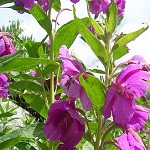 This is the family of Onagraceae of the garden evening primeroses. Here belongs the somewhat little known, but nevertheless wonderfully beautiful Epilobium from the Himalaya with zygomorphic blue or purple flowers, commonly in bloom during August at elevation immediatly above the timberline. The Pink Evening Primerose , also called Oenothera rosea has a size ranging between 10 to 40 cm. The 4 petaled flower orginates in South America but is now found in Kathmandu.
This is the family of Onagraceae of the garden evening primeroses. Here belongs the somewhat little known, but nevertheless wonderfully beautiful Epilobium from the Himalaya with zygomorphic blue or purple flowers, commonly in bloom during August at elevation immediatly above the timberline. The Pink Evening Primerose , also called Oenothera rosea has a size ranging between 10 to 40 cm. The 4 petaled flower orginates in South America but is now found in Kathmandu.
12) Carrot family - Umbelliferae
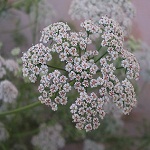 The widely distributed Umbelliferae of aromatic herbs, at once recognized by their umbellate inflorescence, 2-celled ovary and usually much divided leaves. In addition to carrot, here belong many other valuable plants like the giant Ferula from the Hindu Kush yielding asafoetida, coriander, aniseed, caraway, cumin seed and celery. Many species grow on grassy meadows and in semi-arid steppes on the Himalaya, often at elevations of 3900m to 5000m; among these the most common are Pleurospermum and Heracleum, herbs with alternate compound leaves, petiole sheathing the stem and small white flowers in compound umbels.
The widely distributed Umbelliferae of aromatic herbs, at once recognized by their umbellate inflorescence, 2-celled ovary and usually much divided leaves. In addition to carrot, here belong many other valuable plants like the giant Ferula from the Hindu Kush yielding asafoetida, coriander, aniseed, caraway, cumin seed and celery. Many species grow on grassy meadows and in semi-arid steppes on the Himalaya, often at elevations of 3900m to 5000m; among these the most common are Pleurospermum and Heracleum, herbs with alternate compound leaves, petiole sheathing the stem and small white flowers in compound umbels.
13) Sunflower family - Compositae
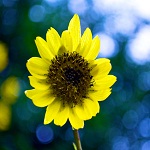 The Compositae family is perhaps the largest one of Dicotyledons, widely distributed in all parts of the world and indeed the dominant family in the Himalaya. In addition to the well known sunflower, the family includes many other garden plants like cosmos, aster, zennia, chrysanthemum, dahlia, etc. On the Himalaya, the family occurs right from the timberline to the highest limits of existence of plants. They are, however, best developped in semi-arid and arid high steppes and some of them at extreme altitudes arc remarkable for the milky latex, aromatic and cottony-woolly leaves. The most striking character of the family is its inflorescence, a capitulum or head. Numerous small flowers, called florets, are arranged close together on the flattened disc-like top of the main inflorescence axis, often with leafy bracts forming an involucre and clustered in the whorls below. Marigold (one of the Compositea) growing plentifully near Phewa Lake. Some other plants from this family are: Anaphalis, Artemisia, Aster, Carduus-Cirsium, Centaurea depressa, Crepis, Echinops, Erigeron, Gerbera kunzeana, Hieracium, Inula obtusiloba, Lactuca tatarica, Saussurea, Senecio, Taraxacum officinale.
The Compositae family is perhaps the largest one of Dicotyledons, widely distributed in all parts of the world and indeed the dominant family in the Himalaya. In addition to the well known sunflower, the family includes many other garden plants like cosmos, aster, zennia, chrysanthemum, dahlia, etc. On the Himalaya, the family occurs right from the timberline to the highest limits of existence of plants. They are, however, best developped in semi-arid and arid high steppes and some of them at extreme altitudes arc remarkable for the milky latex, aromatic and cottony-woolly leaves. The most striking character of the family is its inflorescence, a capitulum or head. Numerous small flowers, called florets, are arranged close together on the flattened disc-like top of the main inflorescence axis, often with leafy bracts forming an involucre and clustered in the whorls below. Marigold (one of the Compositea) growing plentifully near Phewa Lake. Some other plants from this family are: Anaphalis, Artemisia, Aster, Carduus-Cirsium, Centaurea depressa, Crepis, Echinops, Erigeron, Gerbera kunzeana, Hieracium, Inula obtusiloba, Lactuca tatarica, Saussurea, Senecio, Taraxacum officinale.
14) Heath family - Ericaceae
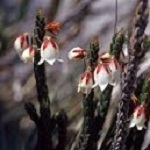 The heath family, typical members of the high altitude flora of Equatorial mountains, is also represented by many interesting species on the Alps and Himalaya. The plants are generally shrubs, but in the upper montane forest grow as trees. Cassiope is a densely tufted, fastigiate dwarf shrub, with white or pink flowers. We find them at an elevation of 3000 to 4200m. Gaultheria a much branched and hirsute shrub, with a small red or white flowers (3000 to 3900m) and Rhododendron of which there are several species, either tall shrubs or small trees and familiar in the Himalayan forest, especially in the Eastern Himalaya. Rhododendron anthopogon, with yellow and Rhododendron campanulatum with purple tlowers, reach the timberline zone of birch-juniper belt in the Himalaya and grow as stunted wind-shaped shrubs, flowering in summer.
The heath family, typical members of the high altitude flora of Equatorial mountains, is also represented by many interesting species on the Alps and Himalaya. The plants are generally shrubs, but in the upper montane forest grow as trees. Cassiope is a densely tufted, fastigiate dwarf shrub, with white or pink flowers. We find them at an elevation of 3000 to 4200m. Gaultheria a much branched and hirsute shrub, with a small red or white flowers (3000 to 3900m) and Rhododendron of which there are several species, either tall shrubs or small trees and familiar in the Himalayan forest, especially in the Eastern Himalaya. Rhododendron anthopogon, with yellow and Rhododendron campanulatum with purple tlowers, reach the timberline zone of birch-juniper belt in the Himalaya and grow as stunted wind-shaped shrubs, flowering in summer.
15) Primerose family - Primulaceae
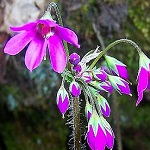 The Primulaceae family is well-known in gardens for their delicate and beautiful flowers, but the family ascends to extreme high altitudes on the Himalaya. Unbelievably delicate flowers, with spreading petals from a short tupe, bloom at the very snow edge. About a dozen flowers are clustered on delicately green, denticulate, boradly lanceolate leaves, at the edge of snow fields, near glacial torrents and on moss cushions near glacial cascades.
The Primulaceae family is well-known in gardens for their delicate and beautiful flowers, but the family ascends to extreme high altitudes on the Himalaya. Unbelievably delicate flowers, with spreading petals from a short tupe, bloom at the very snow edge. About a dozen flowers are clustered on delicately green, denticulate, boradly lanceolate leaves, at the edge of snow fields, near glacial torrents and on moss cushions near glacial cascades.
Androsace with rosulate or imhricate leaves small white or red flowers; Androsace lanuginosa; Androsace microphylla, Androsace semperviveides and Androsace septentrionalis are the common species at elevation 3600 to 5200m.
16) Gentian family - Gentianaceae
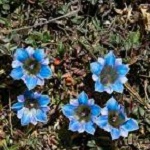 The Gentianaceae is family of beautiful herbs with opposite entire leaves and usually regular flowers in terminal clusters. The calyx is often 4-7-lobed and the corolla tube is funnel shaped or cylindrical, with 4-7 petals and as many stamens. Gentiiana has small cluster of 3-4 deep purple-blue flowers at the tip of a short stalk. Each flower is about 50mm long, in which the corolla is fitted into rectangular column, above which the petals flare up horizontally outwrd. The stamens are golden yellow. The flowerrs open in bright sunshine, but close up in cloudy intervals. Exacum is a small herb with blue flowers (sometimes). Another Himalayan plant is Swertia with blue flowers.
The Gentianaceae is family of beautiful herbs with opposite entire leaves and usually regular flowers in terminal clusters. The calyx is often 4-7-lobed and the corolla tube is funnel shaped or cylindrical, with 4-7 petals and as many stamens. Gentiiana has small cluster of 3-4 deep purple-blue flowers at the tip of a short stalk. Each flower is about 50mm long, in which the corolla is fitted into rectangular column, above which the petals flare up horizontally outwrd. The stamens are golden yellow. The flowerrs open in bright sunshine, but close up in cloudy intervals. Exacum is a small herb with blue flowers (sometimes). Another Himalayan plant is Swertia with blue flowers.
17) Borage family - Boraginaceae
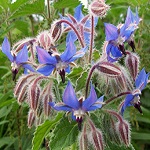 The Boraginaceae family or the forget-me-not, with the regular flowers is represented in the Himalayan by Arnebia (3900m) with yellow or white flowers, Cynoglossum with blue (sometimes also pink) flowers at 3600m of elevation, Eritrichium with small blue flowers at 4900m of elevation, Lindefolia with blue or pink flowers at 3000-4500m and Myosotis with blue flowers changing to red or white (3000-5100m). Blue flower of Myosotis sylvatica is another beautiful example in this family. The Cyonoglossum zeylanicum occur at 1500m of elevation.
The Boraginaceae family or the forget-me-not, with the regular flowers is represented in the Himalayan by Arnebia (3900m) with yellow or white flowers, Cynoglossum with blue (sometimes also pink) flowers at 3600m of elevation, Eritrichium with small blue flowers at 4900m of elevation, Lindefolia with blue or pink flowers at 3000-4500m and Myosotis with blue flowers changing to red or white (3000-5100m). Blue flower of Myosotis sylvatica is another beautiful example in this family. The Cyonoglossum zeylanicum occur at 1500m of elevation.
18) Mint family - Labiatae
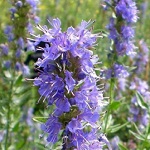 The mint family (Labiatae) is widely distributed and easily recognized by the rectangular square-sectioned stem, whorled or verticillate inflorescence of two-lipped flowers, simple opposite leaves. Here belong the sacred tulasi plant, lavender and other beautiful garden plants. On the Himalaya the family flourished at elevation from 3600 to 5000 m, with many aromatic herbs like Calamintha, Dracocephalum, Hyssopus, Nepeta, Origanum, Perovskia, Phlomis, Thymus, etc. Dracocephalum with blue or purple flowers occurs on grassy meadows at 3000 to 5000m and Thymus linearis is perhaps the most typical aromatic prostrate and much branched herb in arid steppes, usually with purple flowers, among boulders and rock crevices.
The mint family (Labiatae) is widely distributed and easily recognized by the rectangular square-sectioned stem, whorled or verticillate inflorescence of two-lipped flowers, simple opposite leaves. Here belong the sacred tulasi plant, lavender and other beautiful garden plants. On the Himalaya the family flourished at elevation from 3600 to 5000 m, with many aromatic herbs like Calamintha, Dracocephalum, Hyssopus, Nepeta, Origanum, Perovskia, Phlomis, Thymus, etc. Dracocephalum with blue or purple flowers occurs on grassy meadows at 3000 to 5000m and Thymus linearis is perhaps the most typical aromatic prostrate and much branched herb in arid steppes, usually with purple flowers, among boulders and rock crevices.
19) Buckwheat family - Polygoinaceae
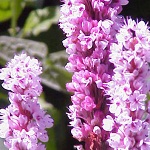 Polygonaceae is the common buckwheat family, to which also belong rhubarb (Rheum), sorrel (Rumex) and Polygonum. The plants are easily recognized by their large and sheating stipules: the spiked flowers have three-enlarged sepals, beautiful coloured like petals. Most species are herbes, with alternate, generally entire leaves and large membranous stipulcs connate to form a tubular shealth at base of petiole. In Polygonum the nuts are not winged, but in Rheum the nut is 3-winbged and are wind dispersed. Most plants are erect glabrous or tufted and sometimes succulent dwarf herbs, with stout rootstock, leaves radical orbicular-cordate or reniform and flowers in auxillary or terminal clusters, occuring in humid and subarid localities from above the timberline to 5000m; grassy meadows are generally crowded with Polygonum sp.
Polygonaceae is the common buckwheat family, to which also belong rhubarb (Rheum), sorrel (Rumex) and Polygonum. The plants are easily recognized by their large and sheating stipules: the spiked flowers have three-enlarged sepals, beautiful coloured like petals. Most species are herbes, with alternate, generally entire leaves and large membranous stipulcs connate to form a tubular shealth at base of petiole. In Polygonum the nuts are not winged, but in Rheum the nut is 3-winbged and are wind dispersed. Most plants are erect glabrous or tufted and sometimes succulent dwarf herbs, with stout rootstock, leaves radical orbicular-cordate or reniform and flowers in auxillary or terminal clusters, occuring in humid and subarid localities from above the timberline to 5000m; grassy meadows are generally crowded with Polygonum sp.
20 Iris family - Iridaceae
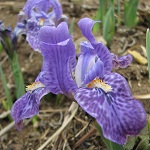 The Irideae are perennial herbs with bulbous (but sometimes also creeping) rootstock; narrow, ensiform leaves; flowers generally yellow, but sometimes also lilac coloured; perianth with large outer segment reflexed and the inner smaller segment suberected. Iris hookerana with linear leaves, outer lobes of perianth obovate, cuneate, purple-blue or usually blotched darker; blooms in early summer at 3600 to 3900m.
The Irideae are perennial herbs with bulbous (but sometimes also creeping) rootstock; narrow, ensiform leaves; flowers generally yellow, but sometimes also lilac coloured; perianth with large outer segment reflexed and the inner smaller segment suberected. Iris hookerana with linear leaves, outer lobes of perianth obovate, cuneate, purple-blue or usually blotched darker; blooms in early summer at 3600 to 3900m.
21) Lily family - Liliaceae
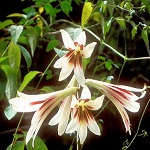 Lily family (or Liliaceae family) include, in addition to the common lilies, many other beautiful and extremely useful herbs like wild lilies, fritillaria, onion, garlic, aspargus, smilax,e tc. Though mostly herbs, smilax is a schrub. The underground stem is a bulb; leaves usually radical; flowers mostly regular, bisexual, often in umbels, with an inferior perianth free from ovary; the perianth often petaloid and usually 6-lobed; stamens 6; ovary superior 3-celled.
Lily family (or Liliaceae family) include, in addition to the common lilies, many other beautiful and extremely useful herbs like wild lilies, fritillaria, onion, garlic, aspargus, smilax,e tc. Though mostly herbs, smilax is a schrub. The underground stem is a bulb; leaves usually radical; flowers mostly regular, bisexual, often in umbels, with an inferior perianth free from ovary; the perianth often petaloid and usually 6-lobed; stamens 6; ovary superior 3-celled.
The important Himalaya lilies grow on grassy meadows and are udually gregarious and often also associated with Ranunculaceae and Umbelliferae. Severals species such as Allium, Fritillaria, Lloydia and Trillidium occur at an elevation between 3600 and 5100m For instance Allium walichii (wild garlic) can occur at an elevation of 3700m.
22) Orchid family - Orchidaceae
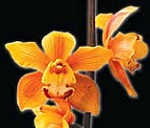 Orchids are found in numbers in Nepal. We can also find flowers of this family (also called Orchidaceae) up to 4500m of elevation. Epiphytic orchids are numerous and more conspicuous than ground orchids, which grow about 3800m upt to 4000m where forest stops. Here are some species of orchids that we find in the Himalaya: Cypripedium himalaicum at 4100m, Aerides multiflora at 1500m, Gastochilus at 1500m and Pleione hookeriana at 2700m.
Orchids are found in numbers in Nepal. We can also find flowers of this family (also called Orchidaceae) up to 4500m of elevation. Epiphytic orchids are numerous and more conspicuous than ground orchids, which grow about 3800m upt to 4000m where forest stops. Here are some species of orchids that we find in the Himalaya: Cypripedium himalaicum at 4100m, Aerides multiflora at 1500m, Gastochilus at 1500m and Pleione hookeriana at 2700m.
23) Amaranth family - Amaranthaceae
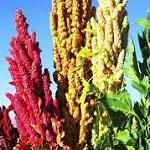 The family of Amaranthaceae comprises 64 genera with 800 species in the world. Out of these species in the Himalaya region, Achyranthes aspera occurs at 3000m, A. bidentata at 1200m, Althernanthesa sessili up to 2000m, Celosia argentia var cristasa up to 1600m, Cyathula tomentosa between 1400 and 2400m of elevation, Gomphrena globosa at 900m up to 1500m, Iresine herbstil in mid hills (1200-1500m)
The family of Amaranthaceae comprises 64 genera with 800 species in the world. Out of these species in the Himalaya region, Achyranthes aspera occurs at 3000m, A. bidentata at 1200m, Althernanthesa sessili up to 2000m, Celosia argentia var cristasa up to 1600m, Cyathula tomentosa between 1400 and 2400m of elevation, Gomphrena globosa at 900m up to 1500m, Iresine herbstil in mid hills (1200-1500m)
Rare flowers of Nepal
With its particular geography, Nepal has many very rare flowers or plants. According to the study by Shrestha and Joshi carried out in 1996, there are 60 species which are not endemic but which are in danger of disappearance. Among the other rare plant species of Nepal we find:
Michelia d'Or (Cichelia champaca)
Spikenard (Nardo stachys grandiflora)
Serpentia (Raulfia serpentina)
Himalayan Yew (Taxus baccata)
Panch Aunle (Pactylorhiza)
Cordyceps (Cordyceps sinensis)
Endangered medicinal plants from Nepal
Tibetan people living in the high mountains quickly understood the importance of plants found on their territory. Even now, they use ancestral knowledge and can cure (at least relieve) several problems. In these Nepalese regions, it is the "amchis" which perpetuate the therapeutic knowledge of several species of plants. In Dolpo alone (region of Nepal), there are more than 400 plants with medicinal properties. Some being analgesic or anesthetic, others meanwhile helping better digestion.
According to the website www.floraofnepal.org, there are at least 20 endangered medicinal plants in Nepal. You can find this list here: Medicinal plants from Nepal.